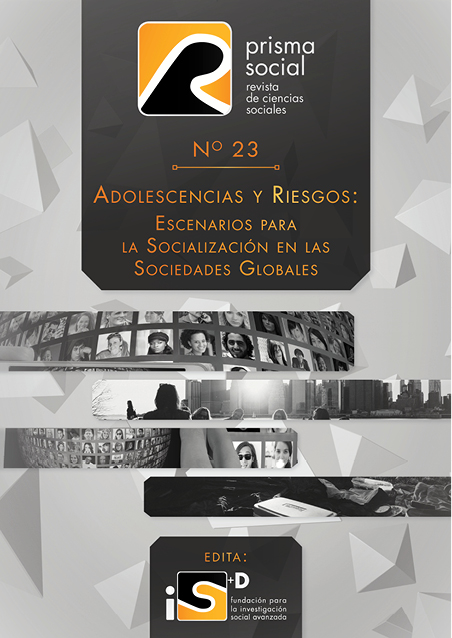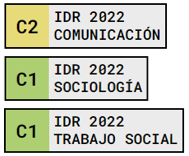Prevalencia, motivaciones y respuestas afectivas del ciberacoso en la red social anónima Curious Cat
Palabras clave:
Ciberagresión, Cibervictimización, Red social, Anonimato, Prevalencia, Curious Cat, Motivación, Respuesta AfectivaResumen
El presente trabajo pretende realizar un análisis de la prevalencia, las motivaciones y las respuestas afectivas en los/as usuarios/as de la red social emergente Curious Cat. Para ello, se realizó el análisis de una muestra no probabilística incidental de 1025 usuarios/as. Se aplicaron versiones adaptadas de los cuestionarios CYBA y CYVIC. Los resultados mostraron que la mayoría de las agresiones era de carácter verbal, y que tenía lugar principalmente por motivos cotidianos. Las amenazas físicas o los ataques debidos a cuestiones de género o identidad sexual resultaron ser muy inferiores. Las víctimas mostraron una tendencia a sentirse indiferentes ante los ataques recibidos, mientras que los/as agresores/as justificaron su conducta amparándose en la hipotética justicia que impartían con sus actos.
Descargas
Citas
Agamben, G. (2000). Lo que queda de Auschwitz: el archivo y el testigo. Homo Sacer III. Valencia: Pre-textos.
Álvarez-García, D., Barreiro-Collazo, A., & Núñez, J.-C. (2017). Ciberagresión entre adolescentes: prevalencia y diferencias de género. Revista Comunicar, XXV(50), 89–97.
Álvarez-García, D., Barreiro-Collazo, A., Núñez, J. C., & Dobarro, A. (2016). Validity and reliability of the Cyber-aggression Questionnaire for Adolescents (CYBA). European Journal of Psychology Applied to Legal Context, 8(2), 69–77. http://doi.org/10.1016/j.ejpal.2016.02.003
Arendt, H. (1999). Eichmann en Jerusalén. Barcelona: Editorial Lumen.
Barlett, C., Chamberlin, K., & Witkower, Z. (2017). Predicting cyberbullying perpetration in emerging adults: A theoretical test of the Barlett Gentile Cyberbullying Model. Aggressive Behavior, 43(2), 147–154. http://doi.org/10.1002/ab.21670
Barlett, C. P., Gentile, D. A., & Chew, C. (2016). Predicting cyberbullying from anonymity. Psychology of Popular Media Culture, 5(2), 171–180. http://doi.org/10.1037/ppm0000055
Bauman, Z. (1997). Modernidad y Holocausto. Madrid: Sequitur.
Becker, J. C., Kraus, M. W., & Rheinschmidt-Same, M. (2017). Cultural Expressions of Social Class and Their Implications for Group-Related Beliefs and Behaviors. Journal of Social Issues, 73(1), 158–174. http://doi.org/10.1111/josi.12209
Brochado, S., Soares, S., & Fraga, S. (2016). A Scoping Review on Studies of Cyberbullying Prevalence Among Adolescents. Trauma, Violence, & Abuse, 152483801664166. http://doi.org/10.1177/1524838016641668
Duncan, S. H., & Brandeis, L. D. (2015). Cyberbullying and restorative justice. Cyberbullying Across the Globe: Gender, Family, and Mental Health, 1, 239–257.
http://doi.org/10.1007/978-3-319-25552-1_12
Gahagan, K., Vaterlaus, J. M., & Frost, L. R. (2016). College student cyberbullying on social networking sites: Conceptualization, prevalence, and perceived bystander responsibility. Computers in Human Behavior, 55, 1097–1105. http://doi.org/10.1016/j.chb.2015.11.019
Garaigordobil, M. (2015). Ciberbullying en adolescentes y jóvenes del País Vasco: Cambios con la edad. Anales de Psicología, 31(3), 1069–1076. http://doi.org/10.6018/analesps.31.3.179151
Garaigordobil Landazabal, M., Martínez Valderrey, V., & Machimbarrena, J. M. (2017). Intervención en el bullying y cyberbullying: Evaluación del caso Martín. Revista de Psicología Clínica Con Niños Y Adolescentes, 4(1), 25–32.
Gilden, A. (2013). Cyberbullying and the innocence narrative. Harvard Civil Rights-Civil Liberties Law Review, 48, 357–407.
Giménez, A. M., Maquilón, J. J., & Arnaiz, P. (2015). Usos problemáticos y agresivos de las TIC por parte de adolescentes implicados en cyberbullying Problematic and aggressive use of ICT in adolescents involved in cyberbullying. Rie, 33(2), 335–351. http://doi.org/10.6018/rie.33.2.199841
Hilberg, R. (1992). Perpetrators, victims and bystanders: The Jewish Catastrophe, 1933-1945. New York: Harper Collins.
Hinduja, S., & Patchin, J. W. (2008). Cyberbullying: An exploratory analysis of factors related to offending and victimization. Deviant Behavior, 29(2), 129–156. http://doi.org/10.1080/01639620701457816
Hinduja, S., & Patchin, J. W. (2017). Cultivating youth resilience to prevent bullying and cyberbullying victimization. Child Abuse and Neglect, 73, 51–62. http://doi.org/10.1016/j.chiabu.2017.09.010
Hosseinmardi, H., Han, R., Lv, Q., Mishra, S., & Ghasemianlangroodi, A. (2014). Towards understanding cyberbullying behavior in a semi-anonymous social network. ASONAM 2014 - Proceedings of the 2014 IEEE/ACM International Conference on Advances in Social Networks Analysis and Mining, 1, 244–252. http://doi.org/10.1109/ASONAM.2014.6921591
Igartua, J. J. (2006). Métodos cuantitativos de investigación en comunicación. Barcelona: Bosch.
König, A., Gollwitzer, M., & Steffgen, G. (2010). Cyberbullying as an Act of Revenge?. Australian Journal of Guidance and Counselling, 20(2), 210–224. http://doi.org/10.1375/ajgc.20.2.210
Lévinas, E. (1993). Entre nosotros. Ensayos para pensar en otro. Valencia: Pre-Textos.
Liu, H. (2007). Social network profiles as taste performances. Journal of Computer-Mediated Communication, 13(1), 252–275. http://doi.org/10.1111/j.1083-6101.2007.00395.x
McInroy, L. B., & Mishna, F. (2017). Cyberbullying on Online Gaming Platforms for Children and Youth. Child and Adolescent Social Work Journal, 1, 1–11. http://doi.org/10.1007/s10560-017-0498-0
Miller, C. (2006). Cyber harassment: Its forms and perpetrators. Law Enforcement Technology, 33(4), 26.
Ortega Ruiz, R., & Córdoba Alcaide, F. (2017). El Modelo Construir la Convivencia para prevenir el acoso y el ciberacoso escolar. Innovación Educativa, (27), 19–32.
Pardo, J. L. (2004). La Regla del juego : sobre la dificultad de aprender filosofía. Barcelona: Galaxia Gutenberg.
Pendergrass, W. S., & Public, A. (2014). Cyberbullied to Death: An Analysis of Victims Taken from Recent Events. Issues in Information Systems, 15(I), 132–140.
Pieschl, S., Kourteva, P., & Stauf, L. (2017). Challenges in the Evaluation of Cyberbullying Prevention - Insights from Two Case Studies. International Journal of Developmental Sciences, 11(1–2), 45–54. http://doi.org/10.3233/DEV-160209
Rafferty, R., & Vander Ven, T. (2014). “I Hate Everything About You”: A Qualitative Examination of Cyberbullying and On-Line Aggression in a College Sample. Deviant Behavior, 35(5), 364–377. http://doi.org/10.1080/01639625.2013.849171
Rodríguez Serrano, A. (2015). Espejos en Auschwitz. Apuntes sobre cine y holocausto. Santander: Shangrila.
Sari, S. V., & Camadan, F. (2016). The new face of violence tendency: Cyber bullying perpetrators and their victims. Computers in Human Behavior, 59, 317–326. http://doi.org/10.1016/j.chb.2016.02.027
Shultz, E., Heilman, R., & Hart, K. J. (2014). Cyber-bullying: An exploration of bystander behavior and motivation. Cyberpsychology, 8(4). http://doi.org/10.5817/CP2014-4-3
Wang, G., Wang, B., Wang, T., Nika, A., Zheng, H., & Zhao, B. Y. (2014). Whispers in the dark: analysis of an anonymous social network. Imc, 12, 137–150. http://doi.org/10.1145/2663716.2663728
Wang, X., Yang, L., Yang, J., Wang, P., & Lei, L. (2017). Trait anger and cyberbullying among young adults: A moderated mediation model of moral disengagement and moral identity. Computers in Human Behavior, 73, 519–526. http://doi.org/10.1016/j.chb.2017.03.073
Žižek, S. (2010). El acoso de las fantasías. Madrid: Siglo XXI de España.
Descargas
Publicado
Cómo citar
Número
Sección
Licencia
Los autores/as que publiquen en esta revista aceptan las siguientes condiciones:
- Los autores/as conservan los derechos de autor.
- Los autores/as ceden a la revista el derecho de la primera publicación. La revista también posee los derechos de edición.
- Todos los contenidos publicados se regulan mediante una Licencia Atribución/Reconocimiento-SinDerivados 4.0 Internacional. Acceda a la versión informativa y texto legal de la licencia. En virtud de ello, se permite a terceros utilizar lo publicado siempre que mencionen la autoría del trabajo y a la primera publicación en esta revista. Si transforma el material, no podrá distribuir el trabajo modificado.
- Los autores/as pueden realizar otros acuerdos contractuales independientes y adicionales para la distribución no exclusiva de la versión del artículo publicado en esta revista (p. ej., incluirlo en un repositorio institucional o publicarlo en un libro) siempre que indiquen claramente que el trabajo se publicó por primera vez en esta revista.
- Se permite y recomienda a los autores/as a publicar su trabajo en Internet (por ejemplo en páginas institucionales o personales), una vez publicado en la revista y citando a la misma ya que puede conducir a intercambios productivos y a una mayor y más rápida difusión del trabajo publicado (vea The Effect of Open Access).


















